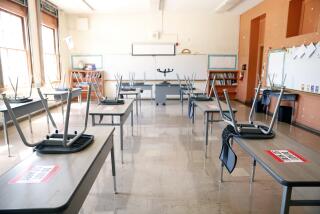Schoos : Class Learns Techniques in Mediation
- Share via
Mark Keppel High School students Tony Montes and Alma Mora glared at each other in mock anger across the table, as student mediator Cassandra Rodriguez settled into a seat between them.
“He slapped me,” Mora said.
“I saw her talking to some guy, joking around. I didn’t like that,” Montes countered.
Rodriguez cleared her throat and began explaining the rules of mediation: “I don’t have the power to make any decision; you have to make it. I will not take sides. There’s no name-calling or put-downs, no physical fighting, and no interrupting.”
The classroom exercise was developed by students in a class on conflict resolution. By September, the 24 students will use their skills to intervene in a variety of real-life conflicts at their high school.
The impetus for the class was a spate of racially charged conflicts between Asian and Latino students at Mark Keppel a year ago. During two days of fighting, police arrested 12 students and confiscated seven knives and a loaded gun.
Through the course, students learn to calm tensions between classmates before they reach boiling point. Beyond intercultural conflicts, they’ll handle boyfriend-girlfriend fights, sibling squabbles and eventually even student-teacher disputes.
English teacher Gabriella Manchester and history teacher Gissella Castro designed the class last fall, pooling material from the Anti-Defamation League and other sources. Hands-on training in conflict mediation is provided by the Martin Luther King Dispute Resolution Center.
About equally divided between Asians and Latinos, boys and girls, the class includes freshmen through seniors, honors students and special-education students.
Teachers throughout the school recommended students who could act as leaders--but not only sports captains and student government members.
“We also chose some non-traditional leaders,” Manchester said, including some who may be associated with gangs. “Kids who assert what teachers call a negative influence, but who nonetheless have great influence.”
The students, earnest and enthusiastic, mix fluidly, as though the racial division that prompted the course doesn’t exist behind the classroom door.
Some say the training has given them insight into their own conflicts.
“It helps you think about what you did wrong and what the other person did wrong,” said junior Gloria Martinez. “Instead of yelling and getting mad it helps you think of what’s really going on.”
More to Read
Sign up for Essential California
The most important California stories and recommendations in your inbox every morning.
You may occasionally receive promotional content from the Los Angeles Times.













